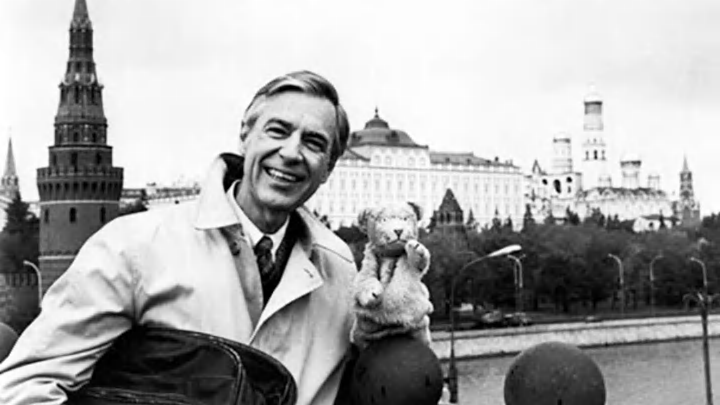After months of hype, the ABC television network premiered a made-for-TV film titled The Day After on November 20, 1983. Presented with minimal commercial interruption, the two-hour feature illustrated a world in which both the United States and Russia made the cataclysmic decision to launch nuclear missiles. The blasts wiped a small town off the face of the Earth; the few who did survive writhed in pain, with their skin hanging off in clumps.
The imagery was graphic and unsettling, and it was supposed to be. Director Nicholas Meyer wanted to portray the fallout in sober detail. The Day After drew a sizable viewership and was hailed as a responsible use of television in order to educate audiences about the reality of the tension between the world’s superpowers.
In the weeks before the film premiered, though, another prominent broadcast was exploring the same themes. It was intended for young audiences and explored—with puppets—the consequences of international aggression. For five episodes across one week, the threat of nuclear annihilation was looming in Mister Rogers’ Neighborhood.
Hot (Nuclear) Button Issues
Since its inception on Pittsburgh’s WQED in 1968, Mister Rogers’ Neighborhood had informed its young audience about topical issues in subversive and disarming ways. When civil rights were discussed, host Fred Rogers didn’t deliver a lecture about tolerance. Instead, he invited a Black friend, Officer Clemmons, to cool off in his inflatable pool, a subtle nod to desegregation. In 1981, Rogers—the subject of 2018’s critically-acclaimed documentary, Won't You Be My Neighbor?—explored the topic of divorce with puppet Patty Barcadi, whose parents had separated. Rogers comforts Prince Tuesday, who frets his own parents might split.
Rogers also explored the disabilities with Jeff Erlanger, a quadriplegic boy who had undergone spinal surgery to remove a tumor. (Decades later, the two were reunited when Erlanger made a surprise appearance as Rogers was being inducted into the Television Academy Hall of Fame.)
Despite Rogers’s history tackling tough topics, there was perhaps no greater a hot-button issue for the children’s show to tackle than nuclear war. Rogers wanted to address what he felt was a growing concern among schoolchildren who processed Cold War headlines and interpreted tensions between Russia and the U.S. as potentially disastrous. (In one survey of classrooms across several major cities, students labeled the possibility of nuclear war “likely.”)
Rogers conceived and taped a five-episode storyline on the subject in the summer of 1983, which wound up being prescient. In November 1983, President Ronald Reagan ordered the invasion of Grenada to topple a Marxist regime.
“Little did I know we would be involved in a worldwide conflict now,” Rogers told the Associated Press. “But that’s all the better because our shows give families an opportunity for communication. If children should hear the news of war, at least they have a handle here, to assist in family communications.”
Bombs vs. Bridges
In the five-part series titled “Conflict,” Rogers again turned to the puppets that populated his Neighborhood of Make-Believe. Provincial ruler King Friday (voiced by Rogers) is handed a “computer read-out” that tips him off to some counterintelligence: Cornflake S. Pecially, ruler of the neighboring land of Southwood, is allegedly making bombs. In a panic, King Friday orders his underlings to do the same, mobilizing efforts to make certain they can match Southwood’s fiery super weapons—even if it means not having the financial resources to care for his people in other ways.
Lady Elaine Fairchilde and Lady Aberlin aren’t quite convinced. Rather than succumb to paranoia, they decide to travel to Southwood to see for themselves. They find its citizens building a bridge, not a bomb. A misunderstanding had almost led to unnecessary violence.
You Might Also Like:
- Quiz: It’s Almost Impossible to Put These Atomic Age Events in the Right Order
- Classroom Cold War: When Students Were Trained to “Duck and Cover”
- Why Do We Still See Fallout Shelter Signs?
Of course, no mushroom clouds envelop the Neighborhood of Make-Believe, and none of the puppets suffers the devastating effects of radiation poisoning. Rogers wasn’t even claiming the story was necessarily about war, but the prevention of it.
“This show gives us a chance to talk about war, and about how it’s essential that people learn to deal with their feelings and to talk about things and resolve conflicts,” he said.
Fallout from “Conflict”
The episodes sparked conversation in classrooms, where some teachers used the footage to broach the subject. At an elementary school in Venetia, Pennsylvania, students in a third-grade social studies class discussed the consequences of war. “No water” was one response. “Injuries” was another.

Unlike The Day After, which one psychiatrist declared inappropriate for children under 12, Rogers proved it was possible to provoke conversation without rattling any nerves.
Following their initial run in 1983, the five-part “Conflict” episodes have never been repeated. The close of the 1980s saw a reduction in concerns over nuclear attacks, and it’s possible producers of Mister Rogers’ Neighborhood regarded the shows as dated.
They resurfaced briefly on YouTube in 2017 before vanishing. Like The Day After, the shows are an interesting time capsule of an era when the fear of devastating conflict was palpable. For a number of kids who experienced that concern, Mr. Rogers helped frame it in a way they could understand.
“I don’t want this to be a frightening thing,” Rogers said. “I want children to know that war is something we can talk about. Whatever is mentionable is manageable.”
Discover More Stories from the Cold War:
A version of this story was published in 2018; it has been updated for 2025.
